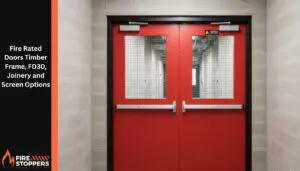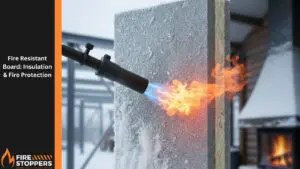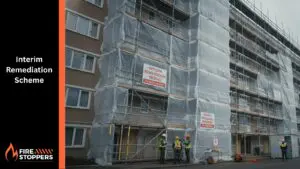Critical Fire Stopping PPM: Your Guide to Planned Preventative Maintenance and Enhanced Building Safety
This comprehensive guide explains the importance of PPM for fire-stopping in Ireland, detailing why a proactive approach to fire stopping services and maintenance of fire systems is essential under Irish legislation. This information helps ensure compliance with the Fire Services Acts 1981 & 2003 and Building Regulations 1997-2019 (Part B – Fire Safety), protecting lives and property while providing valuable insights for anyone responsible for facility management, building safety, or fire prevention strategies in Ireland.
Table of Contents
Table of Contents
- Critical Fire Stopping PPM: Your Guide to Planned Preventative Maintenance and Enhanced Building Safety
- Table of Contents
- What Exactly is Firestopping and Why is it a Cornerstone of Passive Fire Protection?
- How Critical is Correct Fire Stopping Installation for Building Safety?
- Why Implement Planned Preventative Maintenance (PPM) for Your Firestopping Systems?
- What are the Dangers of Overlooking Firestopping and Fire Door Maintenance?
- Are Regular Firestopping Inspections Mandatory Under Building Regulations?
- What Does a Comprehensive Firestopping Inspection Actually Involve?
- How Does Fire Compartmentation Rely on Effective Firestopping?
- Why Should You Always Choose Accredited Fire Stopping Services?
- Beyond Walls: Do Fire Doors and Fire Dampers Need PPM Too?
- What Steps Ensure Your Firestopping PPM Strategy is Effective and Compliant?
- Key Takeaways
What Exactly is Firestopping and Why is it a Cornerstone of Passive Fire Protection?

Firestopping is a fundamental component of passive fire protection. It involves using specific materials to seal openings and joints in fire-resistant rated walls and floors. These openings often accommodate service penetrations like pipes, cables, and ductwork. Without effective firestopping, these penetrations become pathways for the spread of fire and smoke between building compartments.
The Primary Goal
The primary goal of firestopping is to restore the fire resistance rating of walls and floors that have been breached by such penetrations. This containment is crucial for fire safety.
Why It’s Essential
The importance of fire stopping cannot be overstated. It directly contributes to ensuring fire safety by maintaining fire compartmentation. This passive fire protection method works silently, unlike active systems like sprinklers that require activation. Effective firestopping:
- Limits the initial development of a fire
- Provides critical time for occupants to escape the building safely
- Protects escape routes
- Helps minimise structural damage to the building
How It Works
Fire stopping systems are tested to specific fire safety standards and designed to withstand high temperatures and prevent the passage of flames, hot gases, and smoke for a specified period. The materials used in firestopping, such as intumescent sealants, collars, wraps, and mortars, react when exposed to heat. This reaction causes them to expand and seal the opening, effectively blocking the fire’s path.

How Critical is Correct Fire Stopping Installation for Building Safety?
Correct fire stopping installation is absolutely critical for overall building safety. A poorly installed fire stopping system can fail prematurely during a fire, negating its protective purpose.
Installation Quality Factors
The effectiveness of firestopping relies heavily on:
- Correct selection of materials for the specific type of penetration and surrounding construction
- Quality of the installation itself
- Installation by competent installers according to manufacturer’s instructions and tested details
Consequences of Poor Installation
The consequences of improper fire stopping installation can be severe:
- Gaps or incorrect materials can allow smoke and fire to bypass the barrier
- Leading to rapid fire spread throughout the building
- Compromises evacuation routes and endangers occupant safety
- Can lead to extensive property damage
Professional Standards
Building owners and occupiers have a responsibility to ensure that all fire safety installations, including firestopping, meet the required standards. This often involves using specialist contractors who can provide evidence of their competence and accreditation. A correct fire stopping installation provides peace of mind and confirms that the building’s passive fire protection measures are robust.
Why Implement Planned Preventative Maintenance (PPM) for Your Firestopping Systems?
Implementing a Planned Preventative Maintenance (PPM) programme for firestopping systems is a proactive approach to fire safety.
The Problem Over Time
Over time, several issues can compromise firestopping:
- Building services are altered
- New penetrations are made
- Existing firestopping materials can degrade or become damaged
Without regular inspection and maintenance of fire stopping, these breaches can go unnoticed, compromising the building’s fire compartmentation.
Benefits of PPM
A firestopping PPM programme:
- Minimises disruption and costs associated with unexpected failures or urgent repair work
- Identifies minor issues before they escalate into significant problems
- Demonstrates commitment to fire safety, crucial under Irish legislation such as the Fire Services Acts 1981 & 2003
- Provides ongoing records of the condition and maintenance of fire stopping within a building
Documentation Value
Regular planned preventative maintenance provides documentation that is invaluable during:
- Fire risk assessment reviews
- Audit processes
- Requests by enforcement authorities
By investing in fire-stopping PPM, building managers ensure their facilities remain compliant with current fire safety standards and that fire stopping systems are always ready to perform their life-saving role.

What are the Dangers of Overlooking Firestopping and Fire Door Maintenance?
Overlooking firestopping and fire door maintenance presents significant dangers to building safety and occupant welfare.
Impact on Fire Compartmentation
Neglected firestopping can lead to breaches in fire compartmentation. These breaches allow fire and toxic smoke to travel rapidly between compartments, potentially:
- Engulfing escape routes much faster than anticipated
- Significantly reducing evacuation time
- Increasing risk to lives and property
Fire Door Failures
Damaged or improperly maintained fire doors, such as those with worn intumescent seals or faulty closing mechanisms, will fail to provide the necessary fire resistance when needed most.
Legal and Financial Consequences
Failure to maintain firestopping and fire doors can lead to severe repercussions:
- Legal compliance issues under Irish building regulations and fire safety legislation
- Enforcement action following inspections by local fire authorities
- Fines and prosecution for non-compliance under the Fire Services Acts
- Insurance complications in the event of a fire
According to the Department of Housing, Local Government and Heritage, there were over 2,000 fire incidents in non-domestic buildings in Ireland in 2023, with the majority of enforcement actions relating to inadequate maintenance of passive fire protection measures. The Fire Services Acts 1981 & 2003 and Building Regulations 1997-2019 mandate that building owners and occupiers ensure fire safety provisions are adequate and maintained.
Are Regular Firestopping Inspections Mandatory Under Building Regulations?
Yes, regular firestopping inspections are effectively mandatory under Irish building regulations and fire safety laws, although specific frequency requirements may vary.
Legal Framework
The Fire Services Acts 1981 & 2003 and Building Regulations 1997-2019 (Part B: Fire Safety) place a duty on building owners and occupiers to ensure the safety of occupants by maintaining fire safety provisions. This includes ensuring that passive fire protection systems, such as firestopping, are kept in good working order.
Fire Risk Assessment Requirements
The requirement for firestopping inspection stems from the general duty of care to maintain fire safety in buildings. A fire risk assessment (which is a legal requirement) should identify the need for ongoing checks of firestopping measures.
Compliance Standards
While specific intervals might not be prescribed universally, the expectation is that inspections are frequent enough to ensure continued integrity. For high-rise buildings or complex structures, the importance of firestopping inspections is even more pronounced.
Failure to conduct such inspections and maintain firestopping could be viewed as negligence and a breach of Irish safety regulations, potentially resulting in enforcement action by local fire authorities.
What Does a Comprehensive Firestopping Inspection Actually Involve?
A comprehensive firestopping inspection is a detailed examination of all accessible firestopping systems within a building.
Initial Documentation Review
The inspection typically begins with a review of existing documentation:
- Building plans
- Previous inspection reports
- Records of any fire stopping installation or remedial work
Physical Inspection Process
During the physical inspection, qualified inspectors examine:
- Service penetrations (pipes, cables, ducts) through fire-resistant walls and floors
- Joints between building elements like wall-to-wall or wall-to-floor junctions
- Signs of damage, incorrect materials, improper installation, or unsealed openings
- Type and condition of firestopping material used
- Suitability for the specific application and fire resistance rating
Documentation and Reporting
The inspection process includes:
- Visual checks and minor intrusive checks where necessary and safe
- Meticulous documentation with photographic evidence
- Detailed report outlining any deficiencies, non-compliances, or areas requiring remedial action
This report forms the basis for necessary repairs or replacements and is a crucial part of the building’s ongoing fire safety management.
How Does Fire Compartmentation Rely on Effective Firestopping?
Fire compartmentation is a fundamental principle of passive fire protection design in buildings, and firestopping plays a crucial role in maintaining its integrity.
What is Fire Compartmentation?
Fire compartmentation involves dividing a building into smaller, manageable sections or “compartments” using fire-resistant walls, floors, and ceilings. The purpose is to:
- Contain a fire within the area where it originates
- Limit spread to other parts of the building
- Protect escape routes
- Minimise potential property damage
The Firestopping Connection
While walls and floors are built to specific fire resistance ratings, they are often breached by essential building services such as:
- Pipes
- Cables
- Electrical conduits
- Ventilation ducts
Each such penetration creates a potential weak point in the fire compartment barrier. Firestopping seals these openings with appropriate fire-resistant materials to restore the original fire resistance rating.
Critical Interdependence
Fire compartmentation and firestopping are intrinsically linked. A fire compartment is only as strong as its weakest point. If firestopping is missing, damaged, or incorrectly installed, the entire fire compartmentation strategy can fail, allowing rapid spread of fire and smoke and undermining the safety design of the building.aged, or incorrectly installed, the entire fire compartmentation strategy can fail, allowing rapid spread of fire and smoke and undermining the safety design of the building.
Why Should You Always Choose Accredited Fire Stopping Services?
Choosing accredited fire stopping services is paramount for ensuring quality, compliance, and effectiveness of your building’s passive fire protection.
What Accreditation Provides
In Ireland, accreditation from recognized third-party certification bodies provides independent verification that a fire stopping installer or service provider meets stringent industry standards. Look for contractors accredited by:
- NSAI Agrément (National Standards Authority of Ireland)
- FIRAS (Fire Industry Research Association Scheme)
- IFC (International Fire Consultants)
- BM TRADA certification schemes
- Other NSAI-recognized third-party certification schemes
These accreditations cover:
- Operative competency
- Quality management systems
- Correct installation techniques
- Use of appropriate, tested fire protection products
Quality Assurance Benefits
When you engage an accredited company:
- Work is carried out correctly by trained professionals
- Regular audits ensure maintained high standards
- Significantly reduced risk of incorrect or sub-standard work
- Protection against costly rework and non-compliance issues
Due Diligence and Peace of Mind
Accreditation provides:
- Clear demonstration of due diligence by building owners and occupiers
- Commitment to fire safety and adherence to best practices
- Valuable records for regulatory audits or insurance claims
- Assurance that systems are installed and maintained by competent professionals
Beyond Walls: Do Fire Doors and Fire Dampers Need PPM Too?
es, absolutely. Planned Preventative Maintenance (PPM) is just as crucial for fire doors and fire dampers as it is for firestopping in walls and floors.
Fire Doors
Fire doors are critical barriers designed to prevent the passage of fire and smoke for a specified period. Over time, they can suffer wear and tear:
- Hinges can loosen
- Intumescent seals can become damaged or detached
- Self-closing mechanisms can fail
A fire door that does not close properly or whose seals are compromised will not provide its rated level of fire resistance.
Fire Dampers
Fire dampers, installed in ventilation ductwork where it passes through fire-resistant barriers, are designed to close automatically in the event of a fire. Common issues include:
- Becoming jammed with dust or debris
- Mechanism failures rendering them ineffective
Comprehensive PPM Approach
Neglecting the maintenance of fire doors and fire dampers severely undermines a building’s overall fire safety strategy. These components must function correctly to maintain fire compartmentation and protect occupants. Incorporating fire door inspection and fire damper checks into your PPM programme is essential for:
- Compliance with Irish fire safety regulations
- Ensuring safety of everyone in the building
- Comprehensive passive fire protection coverage
What Steps Ensure Your Firestopping PPM Strategy is Effective and Compliant?
Ensuring your firestopping Planned Preventative Maintenance (PPM) strategy is effective and compliant involves several key steps.
Step 1: Comprehensive Fire Risk Assessment
- Conduct a thorough fire risk assessment or review your existing one
- Specifically identify all areas requiring firestopping and their current condition
- Understand specific fire resistance requirements for different compartments
- Let this assessment inform the scope and frequency of your PPM activities
Step 2: Engage Professional Services
- Use competent and preferably fully accredited fire stopping services (NSAI, FIRAS, IFC, BM TRADA, or other recognized schemes)
- Ensure professionals have expertise to identify defects accurately
- Apply correct fire stopping solutions
- Maintain detailed records of all findings, work carried out, materials used, and dates
Step 3: Integration and Continuous Improvement
- Integrate firestopping PPM into your overall building fire safety management system
- Schedule regular reviews of the PPM plan itself
- Ensure relevance especially after building alterations or occupancy changes
- Provide training for relevant staff on fire stopping importance
- Maintain systematic record-keeping as part of robust PPM approach
Documentation Requirements
A proactive and well-documented planned preventative maintenance programme is fundamental to:
- Ensuring fire safety
- Protecting lives and property
- Meeting legal obligations under current Irish fire safety legislation
- Demonstrating compliance during audits by local fire authorities
Key Takeaways
Critical for Safety
Planned Preventative Maintenance (PPM) for firestopping is essential for maintaining building safety and effective fire compartmentation.
Compliance Obligation
Regular inspection and maintenance of fire stopping are necessary to comply with Irish fire safety regulations including the Fire Services Acts 1981 & 2003 and Building Regulations 1997-2019 (Part B: Fire Safety).
Prevents Fire Spread
Effective firestopping seals penetrations in fire-resistant structures, preventing the rapid spread of fire and smoke.
Installation Quality
Correct fire stopping installation by competent professionals is as important as the materials used.
Accreditation Matters
Always choose accredited fire stopping services (NSAI, FIRAS, IFC, BM TRADA, or other recognized schemes) to ensure work is performed to high standards by qualified installers.
Comprehensive Approach
Your PPM should also include fire doors and fire dampers, which are integral to passive fire protection.
Risk Assessment Foundation
A thorough fire risk assessment should inform the scope and frequency of your firestopping PPM.
Documentation is Key
Maintain detailed records of all inspections, remedial works, and fire stopping materials used.
Proactive, Not Reactive
A PPM strategy is a preventative measure that minimises risks, disruption, and potential costs associated with fire damage.
Continuous Integrity
Regular checks ensure firestopping and fire compartmentation remain intact over the building’s lifespan, protecting occupant safety.
This guide provides comprehensive information on firestopping PPM to help facility managers, building owners, and safety professionals maintain effective passive fire protection systems in Ireland. Regular maintenance and professional inspections are not just best practice—they are essential for legal compliance under Irish fire safety legislation and occupant safety.



